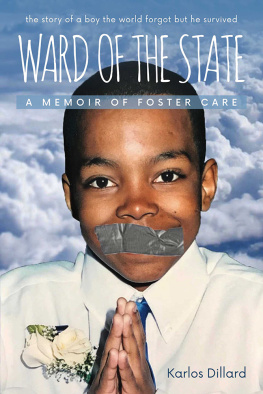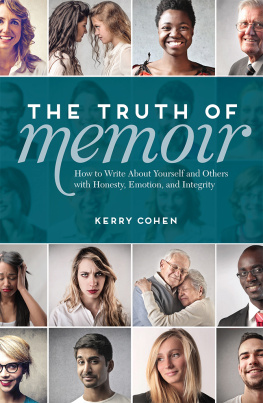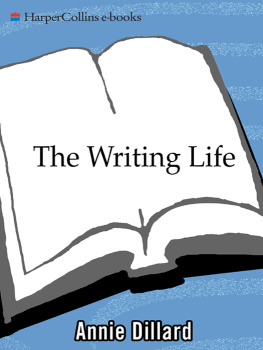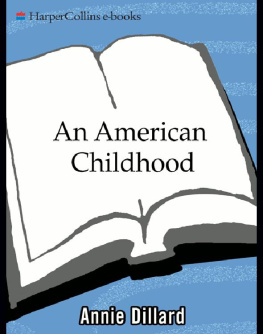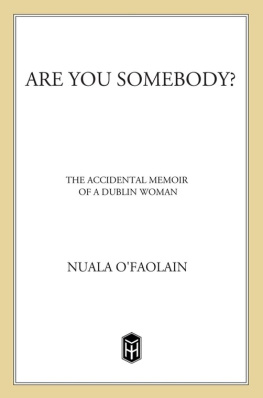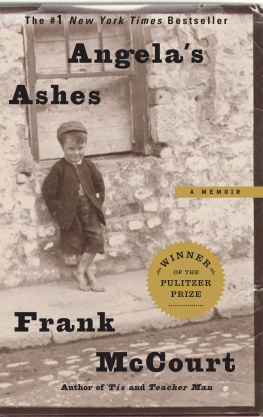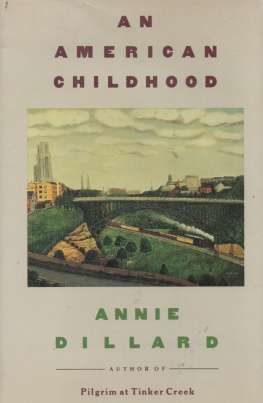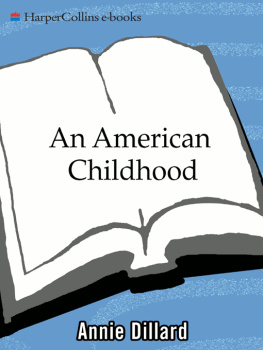FIRST MARNIER BOOKS EDITION 1998
Copyright 1998 by William K. Zinsser.
All rights reserved.
Introduction, copyright 1987, 1995, and 1998 by William K. Zinsser. Life with Mother, copyright 1987 by Russell Baker. To Fashion a Text, copyright 1987 by Annie Dillard. The Past Breaks Out, copyright 1987 by Alfred Kazin. The Site of Memory, copyright 1987 by Toni Morrison. Poets in My Youth, copyright 1995 by Eileen Simpson. Looking for My Family, copyright 1995 by Ian Frazier. Lifting the Veil, copyright 1995 by Henry Louis Gates, Jr. Points of Departure, copyright 1995 by Jill Ker Conway. Learning to Chill Out, copyright 1998 by Frank McCourt.
For information about permission to reproduce selections from this book, write to or to Permissions, Houghton Mifflin Harcourt Publishing Company, 3 Park Avenue, 19th Floor, New York, New York 10016.
hmhco.com
The Library of Congress has cataloged the print edition as follows:
Inventing the truth : the art and craft of memoir / Russell Baker
...[et al.] ; edited with an introduction by William Zinsser. Rev. and expanded ed., 1st Mariner books ed.
p. cm.
A Mariner book.
Includes bibliographical references (p. ).
ISBN 0-395-90150-2
1. Autobiography. 2. United StatesBiography History and criticism. 3. Authors, American 20th centuryBiographyHistory and criticism. I. Baker, Russell, 1925 . II. Zinsser, William Knowlton.
CT 25.158 1998 98-7926
920.073 dc21 CIP
e ISBN 978-0-547-52745-1
v2.0518
WILLIAM ZINSSER: Introduction
This is the age of the memoir. Never have personal narratives gushed so profusely from the American soil as in the closing decade of the twentieth century. Everyone has a story to tell, and everyone is telling it.
The boom has its ultimate symbol in Angelas Ashes, Frank McCourts account of his squalid childhood in an Irish slum. In its literary shape its a classic memoir, recalling a particular period and place in the writers life. It also hit the double jackpot of critical and popular success, winning the Pulitzer Prize and perching at the top of the bestseller lists for well over a year. Beyond all that, its the perfect product of our confessional times. Until this decade memoir writers tended to stop short of harsh reality, cloaking with modesty their most private and shameful memories. Today no remembered episode is too sordid, no family too dysfunctional, to be trotted out for the wonderment of the masses in books and magazines and on talk shows.
The marvel of Frank McCourts childhood is that he survived it, as he himself notes in the third sentence of his book. The second marvel is that he was able to triumph over it in Angelas Ashes, beating back the past with grace and humor and with the power of language. Those same qualities are at the heart of all the good memoirs of the 1990sbooks such as Pete Hamills A Drinking Life and Mary Karrs The Liars Club and Tobias Wolffs This Boys Life. Anyone might think that the domestic chaos and alcoholism and violence that enveloped those writers when they were young would have long since hardened the heart. Both Karr and Wolff were lugged around the country by barely competent mothers running from unstable males and taking up with men who were even worsenightmarish new stepfathers for children whose real fathers had forsaken them. Yet they look back with compassion.
My mother didnt read this book until it was complete, Mary Karr writes in her preface. However, for two years she freely answered questions and did research for me, even when she was ill. She has been unreserved in her encouragement of this work, though much in the story pains her. Her bravery is laudable. Her support means everything. Tobias Wolff also withheld his memoir from his mother, and he was nervous about how she would react to it. In her life she didnt get anything right, he once said, except one thing, and that was love. After reading the book she said: Im glad you didnt tidy me up and turn me into someone I wasnt. That would have meant that I hadnt been of any use to you as a mother.
If these books by McCourt, Hamill, Karr, and Wolff represent the new memoir at its best, its because they were written with love. They elevate the pain of the past with forgiveness, arriving at a larger truth about families in various stages of brokenness. Theres no self-pity, no whining, no hunger for revenge; the writers are as honest about their own young selves as they are about the sins of their elders. We are not victims, they want us to know. We come from a tribe of fallible people, prisoners of our own destructiveness, and we have endured to tell the story without judgment and to get on with our lives.
Such tolerance, however, is no longer an American virtue. The national appetite for true confession has loosed a torrent of memoirs that are little more than therapy, the authors bashing their parents and wallowing in the lurid details of their tussle with drink, drug addiction, rape, sexual abuse, incest, anorexia, obesity, codependency, depression, attempted suicide, and other fashionable talk-show syndromes. These chronicles of shame and victimhood are the dark side of the personal narrative boom, giving the form a bad name. If memoir has become mere self-indulgence and reprisalso goes the argumentit must be a degraded genre.
The truth is that memoir writing, like every other kind of writing, comes in both good and bad varieties. Thats the only standard that matters. Whether the authors of certain notorious recent memoirs ought to have revealed as much as they did, breaking powerful taboos and social covenants, isnt finally the issue. The issue is: Is it a good book or a bad book?
A good memoir requires two elementsone of art, the other of craft. The first element is integrity of intention. Memoir is the best search mechanism that writers are given. Memoir is how we try to make sense of who we are, who we once were, and what values and heritage shaped us. If a writer seriously embarks on that quest, readers will be nourished by the journey, bringing along many associations with quests of their own.
The other element is carpentry. Good memoirs are a careful act of construction. We like to think that an interesting life will simply fall into place on the page. It wont. We like to think that Thoreau went home to Concord and just wrote up his notes. He didnt. He wrote seven drafts of Walden in eight years, piecing together by what Margaret Fuller called the mosaic method a book that seems casual and even chatty. Thoreau wasnt a woodsman when he went to the woods; he was a writer, and he wrote one of our sacred texts. Memoir writers must manufacture a text, imposing narrative order on a jumble of half-remembered events. With that feat of manipulation they arrive at a truth that is theirs alone, not quite like that of anybody else who was present at the same events.
This phenomenonmultiple ownership of the same pastwas first revealed to me in the 1960s, when I was invited to write one-fifth of a book. It was called Five Boyhoods, and it consisted of memoirs written by five men who grew up in successive decades of the twentieth century. The first chapter, by Howard Lindsay, described his turn-of-the-century boyhood in Atlantic City, a sunny Victorian world not much different from the one he would inhabit many years later as coauthor and star of one of Broadways longest-running plays, Life with Father. The second chapter (1910s), by Harry Golden, evoked a world as cramped as Lindsays was spacious: the dark ghetto of immigrant Jews on New forks Lower East Side. Chapter 3, on the 1920s, was by Walt Kelly, who belonged to an Irish clan that seemed to be in perpetual migration between Bridgeport and Philadelphiahardly the twenties of F. Scott Fitzgeralds Jazz Age, but could Fitzgerald have created Pogo? My chapter (1930s) was about a boyhood spent in a vale of prosperous WASPs on the north shore of Long Island, and the fifth chapter, by John Updike, recalled what it was like to grow up in the 1940s as the only child of schoolteachers in a small town in Pennsylvania. Updikes father, haunted by the fear of poverty, was glad the family lived next to a poorhouse; if necessary he could walk there.


